Country & Marine Parks
WORK OF THE COUNTRY AND MARINE PARKS BRANCH
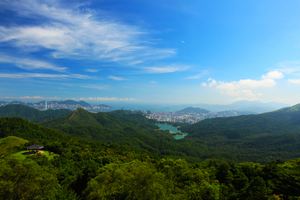
- To conserve the natural environment through the identification, designation and management of suitable areas as country parks, special areas, geopark, marine parks and marine reserves;
- To conserve important marine and terrestrial fauna and flora, such as the Chinese white dolphins, finless porpoises, coral communities, birds, mammals, butterflies and dragonflies;
- To promote nature appreciation through publicity and educational activities and the provision of suitable facilities.
COUNTRY AND MARINE PARKS
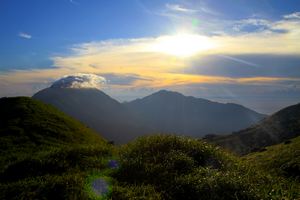
To conserve the countryside, as at March 2015, 44,300 hectares (about 40% of Hong Kong's total land area) have been designated as country parks and special areas. The Department manages all 24 country parks and 22 special areas for conservation, recreation, education and tourism. Hiking trails, mountain bike trails, nature trails, barbecue and picnic sites, camp sites and visitor centres are provided in the country parks, drawing some 11.73 million visitors in 2014-15.
The Department manages four marine parks and one marine reserve covering 2,430 hectares for conservation, education and scientific studies. Marine parks, which are also for recreation, comprise scenic coastal areas, seascapes and important marine habitats with an abundance of important marine fauna and flora, providing ideal opportunities for diving, snorkelling, canoeing and underwater photography. Some 126,350 visitors to marine parks were recorded in 2014-15.
A map showing the country parks, special areas, marine parks, marine reserve and the Hong Kong Global Geopark of China is at Appendix 13.
COUNTRY PARK ENCLAVES
The Department commenced management of three country park enclaves, namely Sai Wan, Kam Shan and Yuen Tun, following their incorporation into the Sai Kung East, Kam Shan and Tai Lam Country Parks respectively in 2013. Suitable locations were identified for planting native tree species to enhance the natural habitats, and installation of country park facilities to provide a pleasant environment for compatible countryside recreation activities. The Department is also proceeding with the proposals to incorporate another two enclaves, namely Fan Kei Tok and Sai Lau Kong into the Plover Cove Country Park and another enclave at the site near Nam Shan into the Lantau South Country Park.
HILL FIRES
In 2014-15, 15 hill fires occurred over an area of 97 hectares with 2,255 trees damaged within or adjacent to country parks. There were a few major fires in Pat Sin Leng Country Park, Tai Lam Country Park and Lantau North Country Park. Rehabilitation planting programme in areas damaged by hill fires and various fire prevention measures have been implemented.
TREE PLANTING
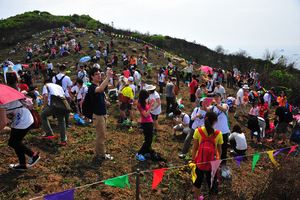
Some 555,900 seedlings were planted in country parks in 2014-15. To enrich local plant diversity, the Department continued to produce and plant seedlings of native tree species. Major native species planted included Castanopsis (Castanopsis fissa), Gordonia (Gordonia axillaris), Sweet Gum (Liquidambar formosana), Zhejiang Machilus (Machilus chekiangensis), Many-nerved Machilus (Machilus pauhoi) and Chinese Gugertree (Schima superba). Among all seedlings planted, about 80% were native species.
Seedlings are produced in Tai Tong Nursery for tree planting in country parks. Located in Tai Lam Country Park with an area of 9.5 hectares, the nursery produced over 555,000 seedlings of more than 100 species in 2014-15.
COUNTRY PARK PLANTATION ENRICHMENT SCHEME
In the early years, exotic pioneer species such as Taiwan Acacia (Acacia confusa), Brisbane Box (Lophostemon confertus) and Slash Pine (Pinus elliottii) were planted to prevent soil erosion and to quickly restore vegetation cover. This objective has been achieved with sustained efforts in the last few decades.
With time, existing plantations in country parks are facing problems such as aging, withering and overgrowing. Trees species found within the plantations are relatively uniform comprising mainly exotic species, making it difficult for them to fully satisfy the needs of native wildlife for food and shelters. In addition, the dense canopies of the trees could have affected the natural propagation of native trees. To enhance the landscape and ecological value of these existing plantations, the Department launched the Country Park Plantation Enrichment Scheme (the Scheme) in 2009 to enrich the overall value of country park plantations. The objectives of the Scheme are as follows:
- To improve the ecological habitat of the plantation areas;
- To increase the biodiversity of both local flora and fauna;
- To allow healthy growth and sustainable development of the woodlands;
- To provide seeds of native trees;
- To enhance the landscape of the country park plantation areas; and
- To reduce the chance of pest outbreaks.
During the dry season of 2014, about 9,500 exotic trees within plantation areas were removed under the Scheme. Over 19,100 suitable native tree seedlings were planted in the plantation areas in the following Spring. It is expected that the newly planted seedlings would gradually establish in the thinned woodland, and eventually replacing all the exotic species. The Department will continue to carry out the Scheme in the coming years to improve the plantations in country parks systematically with a view to enhancing the overall ecological value of the country parks.
In addition to enhancing the ecological value of country park plantations, thematic planting displaying colors of seasonality was conducted in selected locations to promote the aesthetic value of woodlands in country parks. A case in point is the red leaves of Sweet Gum trees (Liquidamber formosana) planted near the Tai Lam Nature Trail in Tai Tong. It has become a major attraction in autumn. The Department would continue to explore suitable locations for other thematic plantings.
TREE MANAGEMENT
To improve tree management in Hong Kong for the sake of public safety, the Department has stepped up efforts on tree inspection, risk assessment and tree maintenance at the recreation sites of country parks and the areas adjacent to non-expressway public roads. Over 38,100 trees (involving about 1,160 sites and 660 tree groups adjacent to public roads) and six Old and Valuable Trees have been inspected. During the year, tree management measures such as pruning and thinning, were prescribed for trees in poor health conditions or with high potential danger to the public. Tree management work was carried out by qualified and experienced in-house staff.
MOUNTAIN BIKE ACTIVITIES
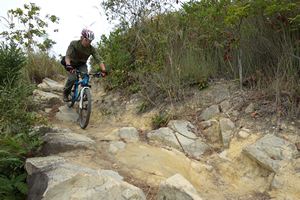
HONG KONG GLOBAL GEOPARK OF CHINA
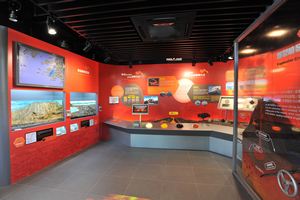
A geopark is a unique natural area with special geological significance. It includes facets of natural and cultural heritage as well as serves the objectives of conservation, education and sustainable development. The purpose of the geopark in Hong Kong, which opened in 2009 and acquired global status in 2011, is to protect Hong Kong’s rich geological resources and their high research, tourism, educational and scenic value.
To better promote the Hong Kong Global Geopark to visitors, a Volcano Discovery Centre opened on 15 July 2014 in downtown Sai Kung. The Centre offers counter services in Cantonese, Putonghua and English, and tells the story of the volcanoes in ancient Hong Kong and how they had shaped the landscape over 100 million years ago. Situated at the gateway to the Geopark, it serves as a convenient starting point for visitors.
On 24 July 2014, the Hong Kong Post issued a new set of definitive stamps on the theme of the Hong Kong Global Geopark of China, featuring 16 most impressive geosites in the Sai Kung Volcanic Rock Region and the Northeast New Territories Sedimentary Rock Region. Hong Kong is the first member of the Global Geoparks Network to showcase geological attractions in stamp design.
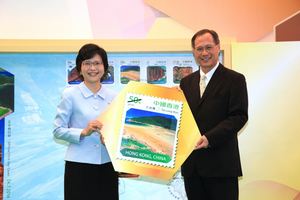
On global networking, the Hong Kong Global Geopark signed sistering and cooperation arrangements with the Lesvos Global Geopark of Greece and the Aso Global Geopark of Japan respectively during the year. Regular knowledge-transfer and networking activities were also held to foster closer relationships with other members of the Global Geoparks Network.
School education is a major focus of the Hong Kong Global Geopark in popularising earth science and geo-conservation. During the year, a wide variety of educational activities, including rock exhibitions, global E-classroom sessions, science experiments, guided visits to geosites, and the Geopark Mentoring Project, were offered to local schools and youngsters from sister geoparks under the Hong Kong Global Geopark School Programme.
MANAGEMENT OF MARINE PARKS
To cope with the rising number of visitors to our Marine Parks, the Department has adopted a series of measures including strengthening patrols, assigning volunteers to disseminate codes for visitors, arrangement of guided activities and publication of educational materials. Law enforcement action was also stepped up to combat illegal activities.
NATURE CONSERVATION EDUCATION
Nature Appreciation Activities

In 2014-15, the Department conducted a series of conservation activities for over 290,000 local students, teachers and nature lovers. The Department continued to carry out the Country Parks Education Programme "Nature in Touch" to strengthen the educational resources on nature conservation in country parks. This programme aimed at promoting a better understanding of country parks, biodiversity, flora conservation and geological characteristics in Hong Kong, thus enhancing public awareness of the importance in protecting the natural environment. The programme included a series of countryside learning activities for students and nature appreciation activities for the public.
School education programme implemented this year included Country Parks Orienteering, Kindergarten, Primary School and Secondary School Visits, and school eco-tours. Besides, "My Waste Reduction Plan Role Play Competition" was held to encourage the children to reduce waste during their daily activities.
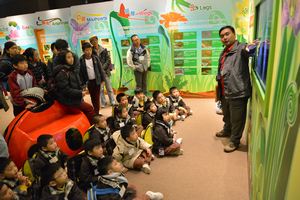
Under the public education programme, a wide variety of activities including guided tours at Nature Education Centres and outdoor tours, "Nature in touch" workshops and themed exhibition and competitions were organised to promote nature conservation. In addition, a number of hiking events including "Hiking and Planting Day", "CAS Hiking Safety Promotion Day", “Keep Fit Party Hiking Event” and “Hiking cum Fun with Nature Carnival” were held to introduce to the public the fun of hiking and the associated safety knowledge.
During this year, some 180 volunteers had completed basic volunteer training under the Country Park Volunteer Scheme. A total of 599 trained volunteers served 31,921 man hours in the country parks conservation and education activities including publicity events, roving exhibitions, guided tours, hiking route patrols, and vegetation management.
Marine Conservation Education Programme
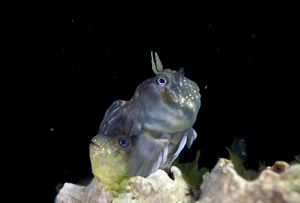
The Department organised a variety of marine conservation education activities targeting various sectors of the community. During the year, 91 public eco-tours, 15 public seminars, seven beach clean-up activities, 45 school lectures, 29 exhibitions and 95 other kinds of educational activities were held, benefiting over 59,000 participants.
In 2010, the Department launched a pilot scheme of fisheries eco-tourism in Sai Kung and the Northeastern waters of Hong Kong in collaboration with local fishermen associations and eco-tourism organsations with an aim to introducing the culture and practices of fisherman communities as well as the ecological and geological features of Hong Kong to the public through marine-based guided tours. It is hoped that the fishermen can gain the experience and skills needed to run the business in a commercially sustainable manner in future. In addition to Sai Kung and the Northeastern waters of Hong Kong, the pilot scheme was extended to Lamma Island in 2011, to Tuen Mun in 2012 and to Tai O waters in 2013, allowing more fishermen to participate in the scheme, better equipping them to switch to sustainable eco-tourism activities. During the year, a total of 29 school tours were held with more than 850 students and teachers participated. Separately, 23 commercial tours were conducted with 686 participants. More than 430 fishermen were trained under this scheme.
To promote the beauty of marine life and habitats as well as enhance public awareness of the importance in conservation of our marine environment, the Department and the Hong Kong Underwater Association co-organised the “Hong Kong Underwater Photo and Video Competition 2014” from May to October 2014. The competition was well-received with a total of 522 entries submitted. The winning entries were exhibited in roving exhibitions at Olympic House, Hong Kong Wetland Park and Hong Kong Convention and Exhibition Centre between October and December 2014.
In collaboration with the Ocean Park Conservation Foundation Hong Kong, Guangdong Oceanic and Fisheries Administration and Macao Civic and Municipal Affairs Bureau, the Department organised “My Ocean Dream - Guangdong-Hong Kong-Macao Marine Life Drawing Competition 2014”. The responses were overwhelming and over 13,000 drawings were received.
The Department organised 20 dolphin field trips for secondary school teachers and students in collaboration with the Ocean Park Conservation Foundation Hong Kong in 2014-15. The field trips provided opportunities for students to watch Chinese white dolphins and to learn more about marine conservation.
During the year, the Department launched a series of publicity and educational activities under Ting Kok Coastal Conservation Plan. These activities included the creation of a website, publication of pamphlets, designation of tour routes and provision of coastal clean-up as well as eco-tour services for visitors.
LAW ENFORCEMENT
Park wardens patrol country parks and special areas on a regular basis to provide visitor services and to enforce the Country Parks Ordinance (Cap 208) and related legislation. In 2014-15, there were 898 concluded prosecution cases in relation to offences in countryside. Statistics are at Appendix 14. Park wardens and nature wardens also conducted frequent special operations in the country parks, such as searching for illegal animal traps, visiting villages for the promotion of fire prevention, enforcing prohibition of feeding wild animals and assisting the Police in search-and-rescue exercises. Regular joint operations with the Police were undertaken to combat crimes, such as illegal felling of Buddhist Pines and Incense Trees.
In marine parks and reserve, wardens patrol on a daily basis, watching out for any illegal fishing activities. Close liaison is also maintained with the Marine Police and the Fisheries Authority of Shenzhen to combat illegal fishing by Mainland fishermen in marine parks. Wardens give advice or warnings to visitors and institute prosecutions when necessary. In 2014-15, 21 prosecutions were instituted against illegal fishing activities in marine parks.
MARINE CONSERVATION
Reef Check
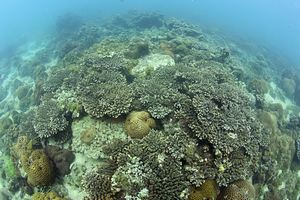
During the year, the Department coordinated the annual Reef Check in collaboration with the Reef Check Foundation. Thirty-three coral sites were surveyed with the assistance of over 650 volunteer divers. Nineteen of these coral sites recorded high coral cover (i.e. more than 50%) and the growth of corals at all sites was stable. Results of the Reef Check were publicised to enhance public awareness of the current status of our marine environment and to seek the public's cooperation in protecting our valuable marine resources. The findings also provided the Department with important information on the health status of corals so that appropriate action could be taken to protect them.
Conservation of Corals
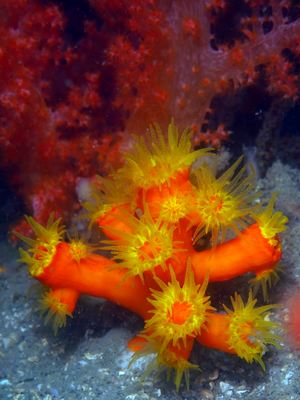
Specially-designed marker buoys were installed at Ung Kong Wan, Sharp Island and Port Island for better protection of corals from anchoring damage. Regular sea patrols and underwater ecological surveys were also conducted to monitor the effectiveness of the coral marker buoys in these areas. The results to date are encouraging. There has been an overall increase in live coral cover in the marker buoy area. Damaged corals have shown signs of recovery.
Conservation of Marine Mammals
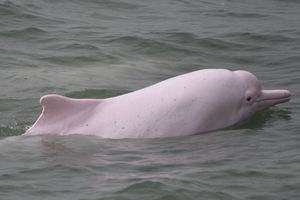
There are some 2,500 dolphins living in the Pearl River Estuary including about 1,300-1,500 dolphins living in the eastern part of the Pearl River Estuary and Hong Kong waters. A study commissioned by the Department on long-term monitoring of marine mammals in Hong Kong, as one of the conservation measures implemented under the conservation programme for the Chinese white dolphin, detected significant declining trends in the number of Chinese white dolphins in Hong Kong waters in recent years. Based on detailed analysis, dolphin abundance in three of the main survey areas, namely West Lantau, Northwest Lantau and Northeast Lantau, showed significant downward trends. The total number in the three survey areas dropped from the highest of 158 dolphins in 2003 to the lowest of 61 dolphins in 2014. Conservation actions including habitat protection and management, long-term monitoring of the dolphin population, investigation of dolphin stranding, promotion of public awareness of dolphin conservation, and liaison with the Guangdong authorities to exchange information on the conservation of the species are being pursued. Variations and trends in abundance of dolphins in Hong Kong waters during recent years are closely monitored. The Department will look into possible causes of the decline in dolphin population and formulate follow-up measures.
Every reported dolphin stranding in Hong Kong was investigated by the Department in collaboration with the Ocean Park Conservation Foundation. Tissue samples from the carcasses were collected for further studies. The Department continued to hold exhibitions and seminars as well as to distribute posters and leaflets to promote conservation of marine mammals, and publicise the code of conduct on dolphin watching and the dolphin stranding hotline. Through these efforts, the public gradually deepened their understanding of marine mammals.
Underwater Ecological Surveys
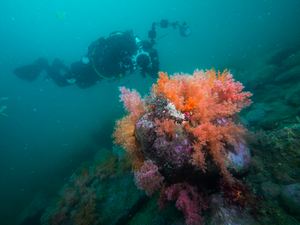
In 2011, the Department formed a diving team for underwater ecological survey comprising staff members who were experienced in scuba diving and underwater ecological survey. During the year, the diving team continued to undertake thematic projects such as the long-term monitoring programmes for hard and soft coral, gorgonian, black coral, reef fish and artificial reefs, and focused studies on coral ecology and algae diversity.
ENVIRONMENTAL IMPACT ASSESSMENT STUDIES
The Department regularly provides comments and advice on development proposals and projects as well as Environmental Impact Assessment studies to ensure that potential impacts of development projects on the marine environment and ecology would be adequately addressed, evaluated and minimised through effective mitigation.
